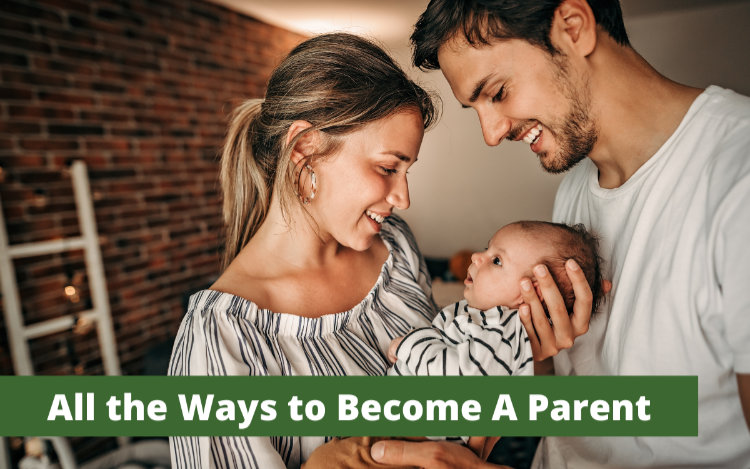Raising children is a goal for many people, and for some, there are unique obstacles. But the good news is that there are many ways to become a parent, which means there are plenty of paths you can take on your journey to parenthood. Whether you’re a single person aspiring to participate in co-parenting, a same-sex or LGBTQIA2S+ couple, or a couple struggling with fertility, this list of all the ways to become a parent can help you decide on your next steps.
Giving Birth.
Becoming pregnant through penetrative sex and giving birth is the way most people with uteruses become a parent—but it’s not the only way.
You can also become a parent if your partner has or will give birth. While it is certainly possible for you to parent the child your partner gives birth to, that is not a requirement of becoming a parent to that child.
You could become a parent if your partner already has a child or if they become pregnant during your relationship with the sperm from another donor (we’ll talk more about fertility treatment later).
Fostering.
There are roughly 500,000 children in the foster care system in America. These children are placed in the care of the Department of Child and Family Services (DCFS) and need Resource Families to care for them.
If your priority is providing a safe, stable, and loving home for a child and you are someone who values growth, learning, and trauma-informed care, then being a foster parent could be right for you.
Fostering children is not always permanent, but many foster children become eligible for adoption after a specified period or circumstances determined by your state.
Co-Parenting.
Co-parenting refers to a lifestyle where you parent a child or children whose other guardians are not your romantic partner.
There is no rigid structure for what co-parenting looks like, but it does require healthy relationship-building skills such as communication, trust, and emotional intelligence.
Through co-parenting, you can become a parent by supporting children in your community in a meaningful and impactful way. You can support a single mother, create a safe space for adolescent family members, and become a role model for children often left to their own devices.
Many children out there who aren’t in the foster care system still need adults like you in their lives, which makes co-parenting a great solution for couples or singles who want to become a parent.
Surrogacy.
When you choose surrogacy, another person will carry your child. People who don’t have bodies that can carry children—like a gay couple where both partners were assigned male at birth (AMAB) or a heterosexual couple with a high risk of complications during pregnancy—often choose surrogacy.
When choosing surrogacy, your surrogate can use their egg, a donor egg, or your egg. The sperm can belong to you or a donor, and you may need to use AI, IUI, or IVF (more on this in the next section).
Fertility Treatment.
If you want to become a parent by giving birth yourself or with a partner, you need three things: viable eggs, sperm, and a person with a uterus to carry the child. Depending on the type of fertility challenges you face, there are unique solutions available.
Fertility Drugs
For people with uteruses, there are a variety of fertility treatment medications that adjust their hormones to make it easier for them to conceive and carry a child. These medications work best when the fertility issues reside with the eggs and/or ovulation.
If you’re struggling with fertility issues, your OBGYN can help you discover the best options for fertility treatments.
Donor Insemination (AI and IUI)
Sometimes the person with the uterus is ovulating normally, which means they don’t need fertility drugs. Instead, the problem lies with the sperm. Either the partner does not have sperm, their sperm aren’t strong swimmers, or they are infertile.
In this case, donor insemination can result in pregnancy. The donor sperm can come from a third-party sperm bank or even a donor you know personally. It could also come from a partner in the relationship.
Artificial insemination (AI) refers to the insertion of sperm within the vagina. In some cases, couples can achieve successful AI at home.
The other option is intrauterine insemination (IUI) which cannot be done at home. During IUI, sperm is inserted directly into the womb close to the fallopian tubes through a catheter. IUI is more involved than AI, but the chances of success are higher.
In Vitro Fertilization (IVF)
IVF is a method where the eggs and sperm are both removed from the donors for fertilization. Viable embryos are inserted into a uterus, where they may implant and result in pregnancy.
IVF can involve hormone injections or be completed via natural cycle IVF (without hormone injections). Usually, IVF is attempted after AI or IUI.
Receiving Donor Eggs
If you have a healthy uterus and viable sperm but no viable eggs, you can acquire donor eggs. Like donor sperm, donor eggs can be acquired from someone you know, or you can purchase them from an agency. Once you have the eggs, they can be implanted into you, your partner, or a surrogate.
Talk To Your OBGYN About Becoming a Parent
If you want to become a parent, consider reaching out to your community and talking to your OBGYN about your options. There is no “right” or “wrong” way to become a parent—just the way that works best for you.
For more information about Women’s Health, or If you’re looking for an OBGYN in the Cincinnati area, call us at 513-241-4774, or schedule your appointment.
